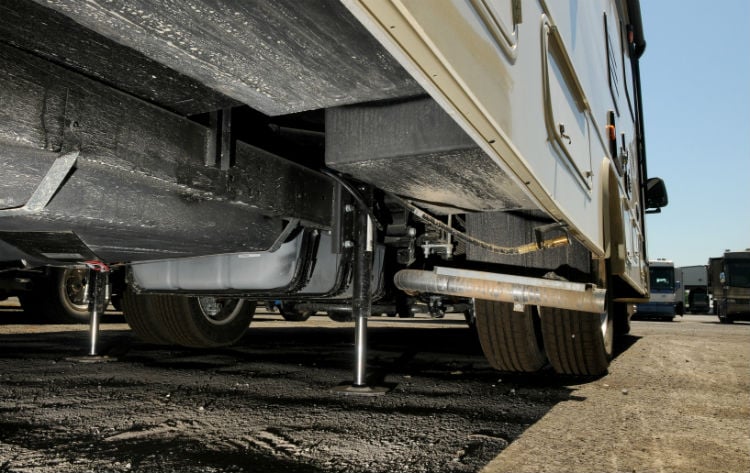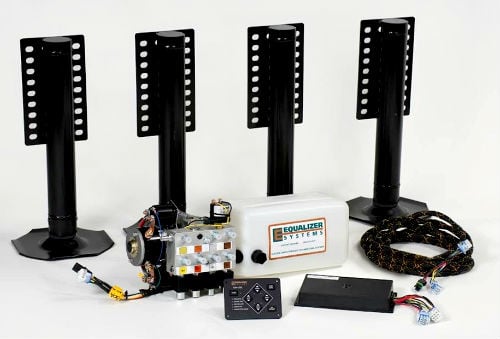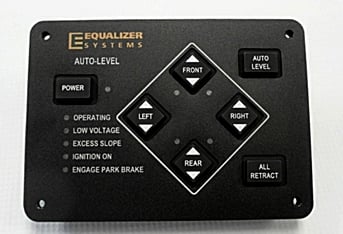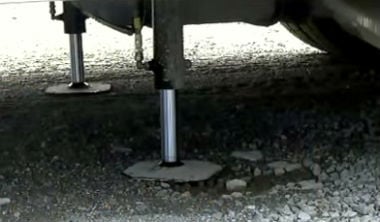
The Equalizer System’s automatic leveling system on the Jayco Greyhawk 29 KS. Photo by Steve Fennell
While most Class A motorhomes roll out of RV manufacturing facilities with installed leveling systems, the same can’t always be said for the popular Class C motorcoaches. Perhaps it’s a matter of setting a price-point, but if you’re shopping for a Class C, leveling systems, or stabilizers, are often available as an option or can be purchased separately from an aftermarket manufacturer.
Properly leveling your Class C doesn’t necessarily mean you’ll be stuck getting down on your hands and knees in the rain setting leveling boards. After-market leveling systems not only level your motorhome with ease, they also provide your coach with something a leveling board can’t achieve – stability.

The SL series of hydraulic levelers from Equalizer Systems.
“The advantages to having levelers on your Class C motorhome are really the same as having levelers on a 40-foot diesel pusher,” says Jamey Lehman of Equalizer Systems in Elkhart, Indiana. “Your coach will always be level and solid. If a Class C has one or more slide outs, having a hydraulic leveling system will make settling in the campground much more enjoyable. No longer will RVers require boards, blocks, rocks or whatever they may have used in the past to get level.”
If you’ve ever walked through your motorhome and felt it was more like a ship at sea, you won’t find that unwelcome pitch-and-roll effect when there are four stable “feet” planted firmly on the ground.
How Hydraulic Levelers work

The control panel of the IR system that mounts inside an RV.
Equalizer Systems manufacturers the SL series of hydraulic levelers that feature an automatic leveling approach. You pull your coach onto the spot of your choice, set the parking brake, and power the system up from a simple control panel inside the RV. Pressing the “auto level” button simply starts up the leveling process.
Mounted under your coach are four hydraulic jacks, controlled by the system’s electronics. The electronics, which are coupled with a single hydraulic pump mounted just about anywhere in your coach, make it happen. First, the system detects what portions of your coach aren’t square with the ground and it extends the corresponding jacks down to the ground, pumping in pressure to lift the coach until it’s level. To ensure complete stability, the system extends all four of the jacks to make solid contact with terra firma. It’s a simple process and takes about two minutes. Once the system has leveled, if you feel a need to tweak it, manual override buttons on the control panel allow you to raise or lower individual jacks.
When it’s time to break camp, simply power up the control panel, push the “all retract” button and the jacks are pumped back into the travel position. If you’re forgetful, don’t worry. If you start your RV, the moment you release the parking brake, the system automatically retracts the jacks for travel and you won’t “drive off” the jacks.
Are Hydraulic Levelers for You?
An automatic leveling system adds a lot of convenience to your RV experience. Quick camp set-up leaves you with more time for recreational activities and the added stability is a blessing. Still, you’ll need to consider all the factors.
- Price: For a typical Class A motorhome on a Ford chassis, a brand-new Auto-Level system will set you back a little more than $3,000 with shipping plus the cost of installation (unless you’re a serious do-it-your-selfer).
- Clearance: You’ll need to have enough ground clearance to keep the jacks out of trouble. Allow between 21 to 25 inches from the top of the chassis frame down to the ground. A safe rule of thumb that Equalizer Systems recommends is having a minimum of eight inches of ground clearance. On the rear of most Class C motorhomes, this means staying within two feet behind the rear axle.
- Weight: If you’re close to the gross vehicle weight limit of your coach, consider the installation of a leveler system like this will add between 150 to 175 pounds. Check your rig’s specifications closely and never push your rig over weight ratings.

Allow the jacks to be between 21 to 25 inches from the top of the chassis frame down to the ground.
Are They Worth It?
Folks who’ve gone from the old school leveling boards to automatic leveling systems often remark that it was the best move they’ve ever made. Typical RVer comments? “Fell in love with my levelers.” “Couldn’t be easier, and my knees stay clean.” “Never go back to the ‘other’ way.” “Money well spent.”
Do it Yourself?
Mounting brackets for the jacks will needed to be welded on – unless you’re installing them on a late model Jayco Redhawk, where the company provides these brackets. The rest is a lot of drilling, bolting, and running of wires and hydraulic lines. Aside from the welding aspects, all you’ll need are typical hand tools, heavy wire for getting power to the hydraulic pump, electrical fittings for the wiring, screws, wire ties, and automatic transmission fluid. But if you’re handy, it is possible to do the install yourself.

I just bought a class c RV and I think it needs sway bars or stabilizers because it started weaving when an 18 -wheeler passed me . It was hard to hold it in the road . Can you help me please
This is amazing, $3000 for a leveling system. I got one on my 2020 Forester that I have owned for almost 2 years (spent 11 months at dealership or factory so they were not used then) and now it is in my driveway with 3 of the jacks down and the system does not work. So I want to try to get my first real trip in the RV this summer and the motorhome is basically a boat anchor, cannot be moved. The One Control state Low Voltage, and there seems to be no advice out on the internet or YouTube where I usually get my information. So even if I can get the jacks to come up, how would I ever have confidence to ever use these while travailing? Maybe the old fashion way is best, carry a lot of lumber (it would be cheaper for sure and more reliable).
This article explains about adding some leveling jacks to a Class C but does not mention any stabilizing jacks or stabilizer products. Leveling gets the coach flat. Stabilizers keep the coach from shaking every time someone rolls over in bed or steps across the floor.
For trailers and fifth wheels, look at something like Steadyfast stabilizers. For Class A and Class C RV’s… that’s what I was hoping this article would describe.